|
The Seals of Unsodo Han
Merrit & Yamada wrote about Unsodo: "Kyoto and Tokyo. Founded 1887.
Yamada Naozo was manager in the first decade of this century (remark: 20th century), Yamada Enji was manager in 1950's,
and a member of the Yamada family was still active in the company in 1983 (remark from the author: In 2002 Yamada Teiichi
is president of Unsodo.). From 1890's until mid 1930's the company manufactured pattern books of the highest
order for artisans and manufacturers of textiles, lacquer, etc. It also produced fine art books with moku-han
color plates. Later printed numerous series of prints of Kyoto subjects."
|
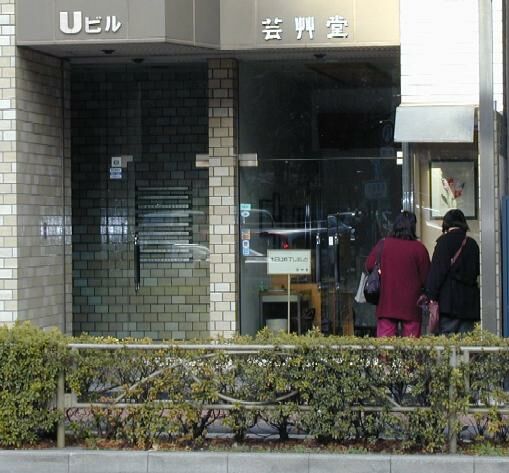
|
|
|
The "U-Building" in Tokyo's Ochanomizu district,
home of Unsodo's Tokyo Branch.
|
Much less is known about Unsodo prints published before WW II, as our knowledge about the seals of Unsodo on woodblock
prints is limited
to the time period following WW II. Apart from shin hanga, Unsodo also published ukiyo-e restrikes
and flower prints.
Artists represented through Unsodo
Shiro Kasamatsu (1898 - 1991)
Mataichiro Isoda (1907 - )
Tomimaru Higuchi (1898 - )
Koichi Okumura (1904 - )
Koichi Okada (1908 - )
Sofu Matsuno (1899 - 1963)
Sofu Hideo (1936 - )
Takeji Asano (1900 - )
Clifton Karhu
The Publisher's Seals of Unsodo:
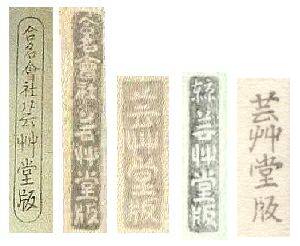
The left seal is in "traditionell style," which reads
top to bottom as "Yugen Gaisha Unsodo Han," and translates as "Limited
Company Unsodo Publisher." This seal is from a 1947 print by Kenji Kawai.
The next seal has the same content, with only the style of carving being
different. The third seal, reading simply "Unsodo Han" is the most common
one. We find it on virtually all prints by Shiro Kasamatsu and Takeji Asano (provided,
published by Unsodo). It is in use since approximately 1950 and is still applied on prints published by Unsodo today.
The forth seal shows only a small difference in the tiny two characters on top: "Tokyo Unsodo
Han." The seal apparently was used for certain prints published by the
Tokyo Branch of Unsodo.
The fifth publishers seal is new and is quite similiar to the traditional third seal (it also reads simply "Unsodo Han") , however its shape is slightly different and it is done black characters set against a white (unprinted) background. It first appeared in 1999 on subsequent reprintings of Kasamatsu's "Nikko Kegon Falls" print.
.
Carver and Printer Seals
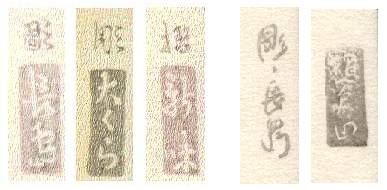
For the vast volume of prints by Shiro Kasamatsu and Takeji Asano surprisingly
only two carvers and a single printer were responsible. The carvers were Nagashima Michio (left and fourth seals, both of which read: "hori (ie, carver) Nagashima")
and Okura Hanbei (second seal: "hori (ie, carver) Okura").
The single printer of nearly all Unsodo prints
is Shinmi Saburo, sometimes also (incorrectly) read as "Niimi Saburo." His seal is the
third one and reads "suri (ie, printer) Shinmi." Shinmi-san is now currently in his 90's and therefore stopped printing many years ago. NOTE: Despite the fact that Shinmi has not printed for a number of years, many of the most recent reprints still (incorrectly) show his seal as printer. For this reason, it is vitally important that the collector either know how to accurately "judge" a print's age by its paper--or trust completely in the knowledge and integrity of its seller.
Finally, only on a very new
restrike,
"Nikko Kegon Falls" by Kasamatsu, do we find since 1999 the seal of Unsodo's new printer "Toda" which is shown on the far right as the fifth seal (it is slightly smaller)--and note, this time the word "suri" (ie, printer) appears WITHIN the black box, rather than above.
The Unsodo Watermark
|
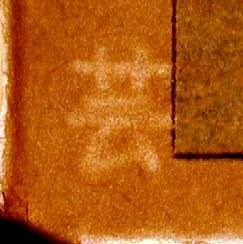
|
Almost all prints published by Unsodo carry the "Un"
watermark in the lower left corner of the paper if the print's image is in vertical format,
otherwise the watermark moves to the upper left corner if the print is in a horizontal format. This character, the first character of the name Unsodo is spelled "Gei,"
(if alone) and means as the combined term "Unso" the extract of a root, which was used traditionally
for paper conservation.
|
Dating of Unsodo Prints
|
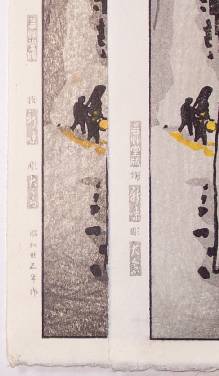
|
The earliest prints by Kasamatsu, Asano, and Okada which were published by Unsodo will always bear their original date of inception as "margin-dating" using Japanese "kanji" characters in the print's lower left margin (see left example). It should be further understood by the collector that since this date is permanently carved INTO the print's black "key-block," any additional prints that might be needed with the passing of a few year's time will therefore still bear this "original date of origination." (It is quite likely, however, that the initial production run of typically 100 prints may well have fulfilled the publisher's inventory needs for a number of years.)
However, around 1960, Shiro Kasamatsu began to carve, print and publish his prints entirely by himself and his collaboration with Unsodo therefore came suddenly to an end. At the same time, both Asano and Okada also ended their association with Unsodo. At this time (approximately 1960), all existing blocks of these three artist's prints which were in the possession of Unsodo had their "margin dates" permanently removed--they were simply carved OFF of the black "key-blocks." Hence, all later reprinted editions of Kasamatsu, Asano and Okada (and probably further artists) do not show any "margin-dating" after about 1960. Therefore, the existance (or lack of) a print's "margin-dating" gives the collector a fairly accurate rough determination at to the era the print was made. For any of these later editions which do not bear "margin-dating," the condition of the paper can give the experienced collector a fairly accurate guide as to the approximate age of a print--for more information see the article "Old Paper" here.
An excellent article by Marc Kahn how to read Japanese style
dates can be found here.
|
(c) Copyright Andreas Grund and Thomas Crossland; 2002




